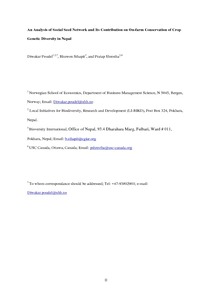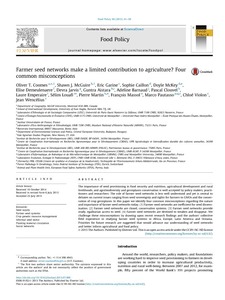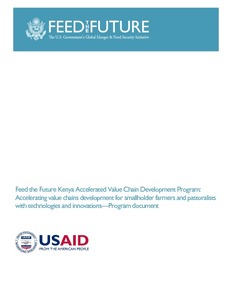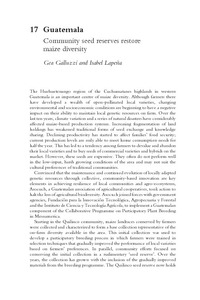Assessing farmers’ perception for resilience of socio-ecological production landscapes in central and eastern Kenya
In order to understand farmers’ perceptions of resilience
in socio-ecological production landscapes and seascapes
(SEPLS), a participatory field assessment was conducted in
Kenya. A tool developed by the United Nations University-
Institute of Advanced Studies and Bioversity International
was used to elucidate the range of perceptions of risk
faced by five communities living in different agro-ecological
and socio-economic conditions. This paper presents
the practical process of carrying out assessments at the
Characteristics of urban and peri-urban agriculture in West Africa: results of an exploratory survey conducted in Tamale (Ghana) and Ouagadougou (Burkina Faso)
The report summarizes key results from surveys carried out on urban and peri-urban agriculture (UPA) in Tamale (Ghana) and Ouagadougou (Burkina Faso) in 2013. The aim was to provide a broad overview of the state of UPA in the study cities and a basis for future research endeavors. The randomized sampling approach used aerial photography to identify 10 sites in different categories of farm in each city. Farmers provided information on their cropping and livestock-rearing activities.
Characterization of Historical Seasonal and Annual Rainfall and Temperature Trends in Selected Climatological Homogenous Rainfall Zones of Uganda
There is general lack of scientific consensus on the trend and distribution of annual and
seasonal rainfall and temperature in Uganda. This study used both observational and AgMerra
rainfall and temperature data for the period 1980-2010 to characterize the trend and variability in
seasonal and annual rainfall, maximum and minimum temperatures across 12 different rainfall
homogenous zones (K, H, ME, L, J, F, MW, D, E, A1, A2, and I) of Uganda. Trends analysis was
done using regression method, while coefficient of variation and ANOVA techniques were used
Competitive farming strategies and their effect on water provision and profitability among smallholder farms: the case of Muooni Dam site, Kenya
Developing a user-based decision-aid framework for water storage systems in Sub-Saharan Africa: the sase of Blue Nile Basin in Ethiopia
The development of water storage schemes in Sub-Saharan Africa (SSA) is considered a major aid for those regions with unequal water distribution, limited accessibility and anticipated climate change impacts. Great attention is given by many SSA countries to set up different water storage schemes that may improve rural and urban development on a national level. The funding for the water storage schemes is often derived from foreign agencies which conduct feasibility studies for the financing of potential investments.
Farmer seed networks make a limited contribution to agriculture? Four common misconceptions
The importance of seed provisioning in food security and nutrition, agricultural development and rural livelihoods, and agrobiodiversity and germplasm conservation is well accepted by policy makers, practitioners and researchers. The role of farmer seed networks is less well understood and yet is central to debates on current issues ranging from seed sovereignty and rights for farmers to GMOs and the conservation of crop germplasm. In this paper we identify four common misconceptions regarding the nature and importance of farmer seed networks today.
Feed the Future Kenya Accelerated Value Chain Development Program: Accelerating value chains development for smallholder farmers and pastoralists with technologies and innovations—Program document
Gender relations and water management in different eco-cultural contexts in northern Thailand
This paper assessed water management by households from three ethnic groups in two contrasting ecological settings (upland and lowland) in the Upper Ping River Basin in Northern Thailand. Important gender differences in the use and management of water were identified. Women are major users of water for agriculture in the uplands, but less so in the lowlands. In the lowlands irrigation is viewed as a masculine activity. In the uplands the role of women is more widely accepted, with women frequently being members of water user groups.






